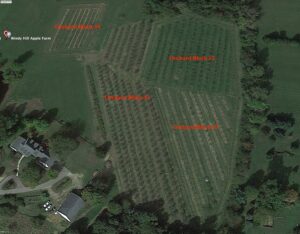Final report for FNC23-1371
Project Information
This project will be carried out by Zachary Dobbelaer, Seth Dobbelaer, and Dr. Paige Kelly. Zachary and Seth both began farming in 2012 under the mentorship of Charlie’s Apples’ founder, Charlie Fritsch. They are responsible for key management strategies such as pruning, mowing, applying inputs, harvesting, etc. In addition to daily tasks, they also work together to create yearly budgets, execute planting/removal schedules, design and implement nutrient programs as well as long-range planning. Throughout the last 10 years they have become highly involved in the agriculture community in a variety of ways. Since 2018, Seth has served as a publicly elected Supervisor for the Licking County Soil & Water Conservation District and currently serves as Board Chair. In 2022, Seth was appointed to the statewide Board of Directors for the Ohio Apple Marketing Program (Ohio Apples). Zachary regularly provides consultation to new and transitioning orchards that are moving into organic or low-chemical production. Since 2021 Zach has served on the Ohio State University Extension Advisory Committee. Based on the depth and diversity of their combined experience, they have the needed skills and knowledge to conduct the proposed project to address the MLB crisis in the orchard with the assistance of the SARE Grant. Dr. Kelly is a post-doctoral researcher at the Ohio State University, having earned her PhD in rural sociology. She will serve as our technical advisor, providing consultation to interpret the observations we make in the orchard as well as statistically analysis to test the significance of our observations for our final report.
Charlie’s Apple Orchard is a certified organic apple orchard in central Ohio. Located on 6 productive acres, we have about 950 apple trees that span four orchard blocks. These orchard blocks vary by planting date, varieties of apples within blocks, and type of rootstocks. Block #1 consists of 300 semi-dwarf Goldrush and Enterprise trees planted in 1995. Block #2 was planted in 2015 and consists of 220 semi-dwarf Goldrush and Enterprise trees. Block #3 consists of 190 semi-dwarf and dwarf trees planted in 2019 – the semi-dwarf trees include Goldrush, Galarenia, and Liberty varieties, while the dwarf trees in this block are exclusively Goldrush variety. Block #4 consists of 250 dwarf Enterprise, Crimson Gold, Crimson Crisp, and Liberty trees planted in 2021. NOTE: as of 2024, Dr. Paige Kelly is no longer affiliated with this project
Beginning in 2021, we noticed that a majority of our trees were losing their leaves and by mid-September some trees were defoliated. Through personal research, support from Ohio State Extension, and contact with the orchard manager at the Rodale Institute, we learned the issue was an emergent disease, Marssonina leaf blotch (MLB). Moreover, we learned that MLB almost exclusively affects organic orchards as commercial orchards’ use of fungicides offer protection against the disease. In the 2022 season, we had almost complete decimation of our operation due to the presence of MLB, with our trees completely defoliated by the first week of September. It is important to note that 2022 had above average rainfall from spring to early summer, which likely exacerbated the presence of MLB.
MLB is a serious threat to the viability of organic apple operations. The purpose of this application is to study viable cultural and/or treatments organic growers can use to combat this new devastating disease within Ohio. If organic controls or new cultural practices are not found to be viable in preventing MLB and its resulting defoliation, we will have to drop our organic certification and use conventional fungicides to address the issue.
SOLUTION
Orchard Block #3 will serve as the control for our project, while Blocks #1, #2, and #4 will receive the intensive sulfur treatment which is the focus of our project. This decision was made due to Block #3 allowing for contrast by apple variety and root stock types. Our four orchard blocks can be seen in the attached image.
Control Block #3
In Block #3 will use management strategies that represent our farm standards as well as the suggested management strategies from organic orchardists in the region for addressing MLB. These strategies includes:
(1) the use of a flail mower beginning in early winter while trees dormant to promote the degradation of MLB. Flail mowers have been shown to be an effective orchard floor sanitation strategy (Cornell Cooperative Extension 2019).
(2) The application of oxidate 2.0 during tree dormancy on trunks, lower limbs, and orchard floor.
(3) Three spray applications of sulfur (Microthiol Disperss) before, during, and after blossom.
Treatment Blocks #1, #2, #4
In Blocks #1, #2, and #4 we will test a more intensive sulfur spray program relative to the farm standard for controlling MLB. In the treatment blocks we will use the same farm standard management strategies as our control block, but we will use intensive spray applications of sulfur at concentrations of 10 lbs/acre and intervals of 7-10 days across the three treatment blocks.
Tracking Efficacy of Treatment
We will compare the MLB damage between the same varieties and root stock types in each orchard block. We will measure the degree of damage for both the foliage as well as the crop quality.
For the degree of foliage damage, we will use a simple scale of 4 degrees of damage:
- Leaves fairly clean of spots
- Leaf spots, minimal defoliation
- Leaf spots with some areas of defoliation
- Severe defoliation of tree
To track the foliage damage, we will survey each orchard block weekly from June to September; this is the key time period in which MLB spores have been detected and symptom development has occurred (Khodadadi et al. 2022). In our final report, we will use these measurements to calculate the percent damage detected across orchard blocks by variety and root stock type. Collecting data across two seasons we will enable us to track seasonal progress in reducing the presence of MLB. This will enable us to see if there is any possible correlation between the pedigree and vulnerability of varieties to MLB.
To measure the quality of crop, Brix level readings will be taken from June to post-harvest. Brix level readings typically fall within 11 to 18 percent sugar content. We will use this as a baseline to evaluate the development and quality of the apples during the growing season and post-harvest. Additionally, we will evaluate crop quality by documenting the apple size and number of apples per bushel post-harvest. In recent years, MLB has resulted in significantly smaller apples and therefore requires more apples per bushel.
OBJECTIVES
- Identify cultural and/or organic control strategies for mitigating damage from Marssonina leaf blotch in organic apple production in Central Ohio.
- Evaluate the efficacy of intensive sulfur treatments in reducing infestation of Marssonina leaf blotch.
- Share findings with regional producers. We will invite managers from orchards within the region, contacts from Ohio State Extension, as well as farm educators from our regional organic certifier, Ohio Ecological Food and Farm Association (OEFFA). Additionally, we will share our project progress through our website and social media updates. We will report on findings at local producer conferences, such as the annual meeting for OEFFA.
Research
- The application of sulfur can have a significant impact on the presence of MLB. However, it is not an airtight solution. In 2024, we learned that severe drought conditions, combined with MLB and lack of irrigation, can still cause widespread defoliation in a chemical-free/organic orchard operation. In 2024, we experienced a severe drought during much of the growing period compared to near-perfect growing conditions in 2023. Total yield, remaining foliage, tree health, and crop quality were still improved from our worst season in 2022 (which was before our intensive sulfur program), but we did report earlier defoliation than in 2023. We believe this is largely due to severe drought conditions.
- We would advise other apple growers to incorporate the use of sulfur as part of their program to combat MLB, but do not expect this treatment to fully solve the problem even with the combination of orchard cleanliness and oxidate 2.0, orchardists are still likely to see adverse impact from MLB. One unexpected and added benefit from intensive sulfur use is the near 100% reduction in sooty-blotch and flyspeck which is an important item to note especially for growers who intend to sell the product at farmers' markets, grocery stores, and pre-picked from their farm.
- A disadvantage of this program is the cost and the labor required to apply this amount of sulfur. It nearly doubled our weekly work and put additional wear and tear on our equipment. Growers who adopt this strategy should expect to spend a significant amount of time on the tractor both in use and cleaning/maintenance. Additionally, we spent nearly $2,900 over 2 years treating 5 acres. However, this did increase our annual gross revenue by more than 10x in the same 2-year timeframe. Total yield also improved during the research period by 1,246% and 1,012% in 2023 and 2024 respectively compared to total yield in 2022.
Step 1: Orchard clean up
We have 4 orchard blocks, though all are in relatively close proximity they are distinctly different in terms of the age of the tree and/or variety. For the first part of the year we treated all the blocks in largely the same way.
Starting in late January of 2023 (we continued this same program in 2024) we began pruning. The first thing we did was walk through the orchard and remove the 2 largest branches of every tree in blocks #1 #2 and #3 (the only pruning we did in block #4 was removing dead or diseased branches because these trees are still very young) wood using a chainsaw in block in #1 (our oldest trees). We then went back through blocks #1 #2 and #3 for the standard orchard pruning. at the same time, we began mowing throughout the orchard using primarily a flail mower which is ideal for mulching any organic matter that’s left on the orchard floor (a mulching mower is ideal for mechanical breaking down any leaves, sticks, drops, etc.) though in some cases we used a zero turn lawn mower and weed wacker mainly in between trees or where it was difficult to maneuver the tractor with the flail mower. We continued to mow across the whole orchard every 3 to 4 weeks, close to 10 times in the growing season.
Step 2: Orchard spray program
Starting in in the early spring/late winter we applied oxidate 2.0 across the whole orchard, (this replaced a dormant oil spray and a dormant sulfur spray) based on the work of Elderberry Pond FNE20-957 , We believe this helped reduce overwintering diseases such as MLB. We applied oxidate across the whole orchard including block #3 (control block) both because we wanted to maintain our standard of applying a dormant spray to control diseases but also so that we could try to isolate results from sulfur applications alone. Starting at petal fall we started applying Microthiol Sulfur.
We applied it at 10lbs per acre (50lbs total) along with a NU Film P (a spreader sticker) all in a 150-gallon tank. An important note is that we use rainwater for all our foliar applications because there is evidence that water quality can have a significant impact on spray efficacy, though this may be more important for chemical or nutrient applications we believe it to be a best practice. Example: Water Quality Pesticide Performance
We continued these sprays every 10 to14 days (or as close to that as we could depending on rain/wind) days with a total of 12 sprays of sulfur being applied to the treatment blocks as referenced in other work it seems to be that the amount of sprays rather than the specific timing has the largest impact.
Example:
Symptom Occurrence and Disease Management of MLB
Tools:
For the spray applications we used a Ford 1520 30 HP diesel tractor in combination with a PTO driven custom built boom sprayer that we have utilized for all nutrient and organic insecticide or fungicides we have used in the past. For those it has been very effective. However, as you’ll see later in our report, it had some limitations when it came to full coverage of the trees.
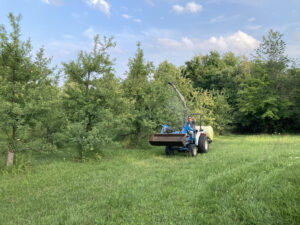
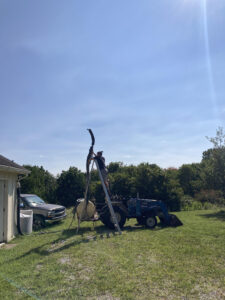
General observations from year two - 2024
In 2024, we harvested 228 bushels which was a 48 bushel decrease from 2023. We attribute the decrease in 2024 largely to the severe drought conditions as well as the bi-annual production of our semi-dwarf trees that we are trying to combat. The quality of the apples remained high and our % of waste from harvested apples remained low. We did report a higher amount of apples dropping from the trees prior to ripening/harvesting. However, we also attribute this to the drought.
For reference, in 2022 before implementing our sulfur program, we had a total yield of 20 bushels which was our worst season on record, and when MLB presence was at its peak in our orchard.
Leaf loss increased in 2024 compared to 2023 as well as the presence of MLB in all but block #4. Blocks #1, #2, and #3 (control block) saw earlier and increased defoliation. However, this was most pronounced in block #3 which serves as the control block that did not receive the intensive sulfur treatment. 100% of the trees in block #3 showed signs of MLB by September - this includes Goldrush on Bud 9 dwarf rootstock as well as other varieties on EMLA 7 semi-dwarf. While this was not the case in the three other orchard blocks that were being treated. There does not appear to be any connection between rootstock, variety and MLB in our orchard
Rootstocks by orchard block:
Block #1 - EMLA 7
Block #2 - EMLA 7
Block #3 - EMLA 7 & BUD 9
Block #4 - BUD 9 & BUD 118
General observations from year one - 2023
Our results in 2023 (our first year using microthiol disperss sulfur, oxidate 2.0, and tracking the presence of MLB) depicted a stark increase in yield, quality, and overall health of the crop compared to previous years. We applied oxidate 2.0 via foliar spray across all orchard blocks in March to help disrupt over-wintering instances of MLB within the orchard. In May during petal fall, we applied 10lbs per acre of microthiol disperss sulfur on all orchard blocks via foliar feed. This was a slight deviation from our original plan of applying 3 sprays of sulfur before, during, and after blossom due to lack of time. However, it is still consistent with how we have utilized sulfur in the past.
Later in May, we began applying sulfur to blocks #1, #2, and #4 at a rate of 10lbs per acre every 7-10 days for a total of 12 sulfur applications via foliar spray. This process is new to us and we used it specifically in an attempt to mitigate the presence of MLB. We began tracking the presence of MLB in June with a weekly orchard walk-through while rating each tree on a scale of 1-4 and saw no indication of MLB until mid August when we started to see a small amount of impact of MLB. In comparison, we saw significant MLB pressure in early August 2022. Images below display the differences:
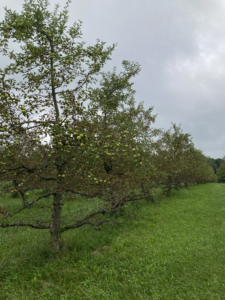
Roughly 50% of leaves on Goldrush trees are brown due to MLB. Block #1.
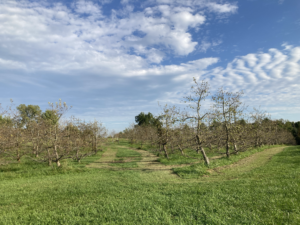
Roughly 90% of Goldrush leaves have dropped from the trees. Block #1.
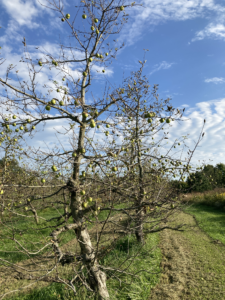
Roughly 90% of Goldrush leaves have dropped from the trees. Block #1.

Goldrush with little to no signs of MLB. Block #1. Compare to pictures from 2022.
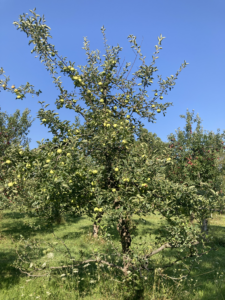
Goldrush with little to no signs of MLB. Block #1. Compare to pictures from 2022.

In this picture, we see the effects MLB on the upper portion of the Goldrush tree but not in the lowers. we believe this is because our sprayer boom does not reach high enough to cover the top of the tree. Block #1.
To put in perspective the drastic differences between our 2022 and 2023 seasons we can look at one simple metric - yield. In 2022, we harvested a total of 20.5 bushels of saleable apples which includes apples being sold whole to consumers and apples pressed into sweet cider. In 2023, we harvested 276 bushels of saleable apples. 2022 was our worst year on record. It's important to note that a year over year comparison is not entirely indicative that the sulfur, oxidate 2.0, and improved orchard cleanliness are the cause of such a significant improvement. However, we do believe that it is a large part of why 2023 we saw a trend in the right direction. Specifically because in 2023, as shown in the above pictures, the trees maintained foliage well into harvest season that begins in late September and concludes in early November. There are other notable differences between 2022 and 2023, including rainfall, temperature in the both the summer and winter months, pollination, etc.
Average MLB rating (June - September) for each orchard block on a scale of 1-4:
- Leaves fairly clean of spots
- Leaf spots, minimal defoliation
- Leaf spots with some areas of defoliation
- Severe defoliation of tree
***time period breakdown determined by when we began to see MLB present.
Block #1
| Week 1 - 8 avg. 1 |
| Week 9 - 12 avg. 2 |
| 299 trees |
Block #2
| Week 1 - 12 avg. 1 |
| 185 trees |
Block #3 (control)
| Week 1 - 8 avg. 1 |
| Week 9 - 12 avg. 2 |
| 172 trees |
Block #4
| Week 1 - 12 avg. 1 |
| 241 trees |
One of the notable results from tracking MLB in 2023 is that we did not see significant difference between the control and study blocks. This could be partially explained by the drier weather we had in 2023 as well as the addition of Oxidate 2.0 and increased flail mower usage. We're interested to see if the control block fairs as well in coming seasons.
Educational & Outreach Activities
Participation summary:
2024:
Our largest opportunity for outreach took place in February of 2025 when we presented at the annual OEFFA conference. This presentation focused on our partnership with SARE and unpacking what we have learned over the last 2 years.
In 2024, we utilized our social media to inform our customers and those who follow us of our research project as well as informal conversations at farmers markets and with customers who visited our orchard to pick and purchase apples. Additionally, we added a tab to our website linking directly to the SARE project page and encouraged individuals to learn more whenever they expressed interest.
We hosted several small groups of folks interested in learning more about how we manage our orchard and what the SARE research project consisted of.
We had regular communication with Branstool Orchards (Utica, OH) and shared how the project was progressing.
2023:
During the 2023 season, we conducted 2 farm tours that included demonstrations and education about our partnership with SARE and how we're using microthiol disperss sulfur in combination with increased mowing and orchard cleanliness to help mitigate the impact of MLB. The first group joined us as part of OEFFA's (Ohio Ecological Food and Farm Association) Sustainable Farm Tour and Workshop series. This tour included 50 participants from around Ohio and surrounding states. Representatives from NRSC, OSU Extension, and the local soil and water conservation districts were also in attendance. The second group joined us from Project Wingspan as part of their educational series and included 8 attendees.

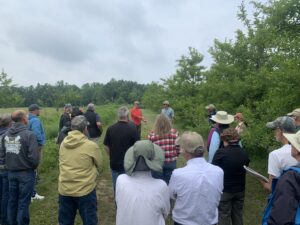
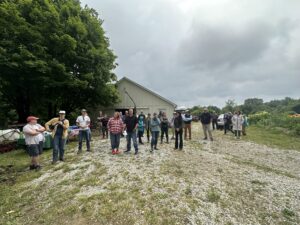
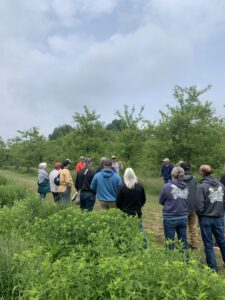
Learning Outcomes
- Orchard clean up, (removing overwintering leaves from the orchard floor) via mulch mowing is possible however it’s incredibly difficult to maneuver the tractor or smaller zero-turn mower between the apple trees (especially our oldest largest trees) because of this many old leaves were left on the ground in a 3-foot strip in the orchard row, this may have contributed to more disease pressure in Block #1.
- Sulfur application: Though we do believe that sulfur can be used as a treatment for MLB it was not universally effective across every Orchard block. In block #4 which is the youngest treatment block MLB was almost totally controlled. A couple of reasons this might be the case. (1) this is a high-density planting, the trees there are relatively small compared to the rest of the orchard, which means we could more effectively cover that block with our sulfur applications compared to our larger trees. (2) the nature of high-density planting allows it to be kept extremely clean, the trees are small allowing excellent airflow and sunlight (this is very beneficial in terms of keeping the canopy dry or drying more quickly after a rain event) additionally it’s far easier to keep the orchard floor clean of any overwintering orchard debris.
- As mentioned earlier, the size and age of the tree were significant factors in the effectiveness of the sulfur treatment in our context in both growing seasons. 2023 and 2024 although because of more extreme weather conditions it was far more clear in 2024. In 2023 we mentioned that in many cases the first signs of MLB began at the very top the tree canopy and moved downward throughout the season. This was even more evident and eventually led to more extreme canopy loss, which was likely due to our sprayer being undersized compared to our largest trees both because it’s slightly shorter than many of our trees in block #1 and perhaps underpowered to fully penetrate the more dense foliage in blocks #1 and #2.
Project Outcomes
In the future, we would like to expand upon this research by also studying how micro-nutrient levels can impact MLB in combination with sulfur treatment by utilizing sap-analysis testing. We will continue to utilize intensive sulfur in the coming years and track disease pressure but may augment the cadence and concentration of each application. We would also like to encourage SARE to fund similar projects as they arise to help determine how this process may impact growers throughout the region.
